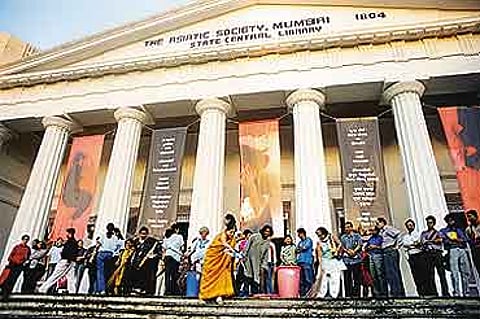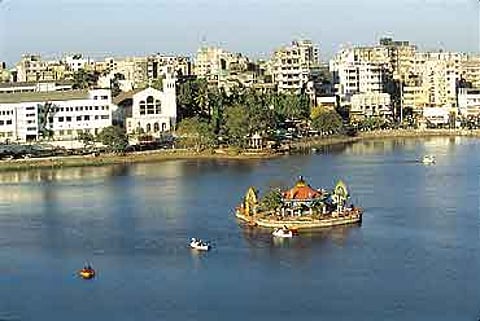In a city where people couldn't be bothered unless their commuter timetables and work schedules were affected, such people-led initiatives are a welcome and positive happening. They are showing results, notably in the transformation of Kala Ghoda, Thane Lake and the Asiatic Society. More and more Mumbaikars, it would seem, are finding value in the joy of public ownership. That's a good thing because such people-led movements (with some support from government or corporates) may be the best bet to save heritage or truly reclaim public areas for citizens.
Most Sunday mornings, small groups of people travel into the central business district of Mumbai, the hallowed fort area, to join trained volunteers on heritage walks. They hear stories of how the army and navy buildings or the David Sassoon Library came about, and they feel—however fleetingly—the excitement of the time when Mumbai was becoming an important port city for the English.
In January, Mumbai saw two events simultaneously—Kala Ghoda Festival, focusing on art and culture, and Mumbai Festival, celebrating the city—that put public spaces to imaginative use. The Gateway of India stage hosted jazz greats like Al Jarreau while roads in tony Powai saw an autorickshaw race and the crowded lanes were cleared for magic shows.
At the Bandra Bandstand, Bandraites are debating intensely if a huge maritime clock should be constructed on the beautiful promenade. For years, the bandstand was a touch-me-not area where illegal booze flowed and petty crime and solicitation were common. Then, Bandraites took charge and, with a little help from the then Rajya Sabha MP Shabana Azmi, turned it into a model promenade with walking-jogging tracks, sit-out benches, even an amphitheatre by the sea. They also fobbed off the state government's plan to transform a ship there into a floating hotel on the grounds that it would have wrecked the coastline.
Everyone's Bombay
Mumbaikars are rediscovering their heritage. A new awareness sees them reclaiming their public spaces.


Mumbai's famous Marine Drive, the historic Gateway of India, the commercially and historically important 600-acre precinct of textile mills in central Mumbai, a slew of other monuments and institutions are now similarly attracting citizens' interest. Public-spirited individuals or small cliques of professionals like architects or historians or simply people living in a particular area have come to believe that only their involvement and participation will allow these monuments or precincts or maidans to remain "public". As Darryl D'Monte, journalist and an active member of the Bandra group, says, "Now more than ever before, I see that people have had enough to do with a non-working government and motivated corporates. I see citizens reclaiming public places or using public places like never before."
The trend of public activism vis-a-vis heritage and public places has picked up enviable momentum. Whether it's a centuries-old church in suburban Marol buried under years of debris and civic neglect or academician Surendra Dighe mobilising groups of young people in Thane to study, beautify and monitor the once-filthy lake, public activism is catching on. "People see it as a service to the city, as a larger cause in Mumbai," says Ganesh.
"The motivating force is not to shut out any player but the coming together of a people celebrating our city, our diversities," says food writer Rashmi Uday Singh, who conceptualised the Food Vertical for the Mumbai festival. Public activism, especially public festivals, need the largesse of corporates and civic cooperation from government agencies but the key is that neither of them is the driving force.
Of course, for the millions commuting to work near Kala Ghoda, the art-culture or heritage may mean little more than a daily canvas. And public activism is most visible among those who are deeply interested in the issues, can spare time, money, ideas and work towards their desired goals.
But it has certainly worked. Kala Ghoda is now an established art and culture precinct with its own festival. Says Sharada Dwivedi, historian-writer and a prime mover of the area's transformation, "We kicked off the fest seven years ago but it took time to catch on. There is 100,000 square feet of gallery space and thousands of square metres of public space. It was up to those interested in art and culture to reclaim the precinct and celebrate it."
>

This year's Kala Ghoda Festival had a special exhibit—the ways in which Mumbai's 600 acres of mill land could be developed. The pictures-drawing-text exhibit also invited people to pen their suggestions. The mill land may not be public property in the strict sense but public activists realise that the mill land redevelopment may well be the last opportunity for Mumbaikars to claim some of it as public land in the space-starved city.
Architects and planners, under the aegis of Urban Design Research Institute, are among those making presentations to the state government on the cohesive use of mill land. Historians, planners, architects are debating plans to redevelop the Gateway of India precinct into a touch-and-feel public place and 3,000-strong capacity public open-air theatre. Eminent architect Charles Correa's plans are the centre of discussions for both venues.
Even in its infancy, public activism could defeat the late Dhirubhai Ambani's plans to beautify the Marine Drive in return for placing his granite plaques every ten metres. Citizens' protests that Marine Drive could not ever be "sold to the wealthy" forced him to retreat. Mumbai seems set for more such spirited activism.
Tags